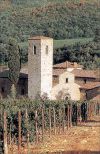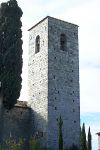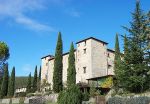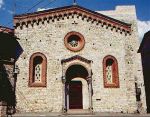
|

|

|

|

|

|

|

|

|

|

|

|

|

|

|

|

|

|

|

|

|

|

|
The Chianti Castles routeLa Strada dei Castelli del Chianti |
|

|
Brown Itinerary - Pieve di Spaltenna, Vertine, Uliveta, S. Donato in Perano, Vistarenni |
|

|

Pieve di Spaltenna |

|
When you return to the main castle route, you enjoy a beautiful view of the Pieve (Parish Church) di Spaltenna on the left above and of the wooded hills that enclose Gaiole in Chianti and you soon reach Gaiole. From the top of one of the surrounding hills, the impressive ruins of Montegrossi dominate. From Gaiole's small ring road, you turn off on the left and rapidly climb to the Pieve di Spaltenna. This is a very old fortified parish church, which is the home of the baptistery of San Piero in Avenano, dating from the 10 C and from which the parish church subsequently acquired its name. Even today, the presence of two "spaltenna" keeps on the downhill corners of the large structure plus some embrasures testify to the character of the building. The name itself testifies to the very ancient Etruscan origin of the settlement. |

|

Pieve di Spaltenna |
|

|
Castle of Spaltenna > > >
with its two "spaltenna" - keeps. |

|

|

|
|
|

|
|
As you continue your ascent, at a turn you will suddenly enjoy the very beautiful view on Vertine. This fortified hill-top village is mentioned in 1013 and again in 1035 when it was described as a possession of a certain, so-far unidentified, Azzo, possibly a member of the Ricasoli family, who lived in Vertine. If was definitely a Ricasoli possession at the end of the next century. The owners of Vertine, descendents of Arrigo Ricasoli, were banned in 1352 by the Florentine Republic for having occupied the parish church of San Polo. However, after reoccupying the castle, they fortified it and made it a base for disruptive incursions all over the Chianti area and they long managed to repel the assaults of the Florentine troops until they were finally obliged to surrender. |

|

Vertine |
|

|
|
The Florentines dismantled the castle and in Vertine they confirmed the ban of those members of the ever-troublesome Ricasoli family. However Vertine remained firmly in the hands of other members of the family and was always considered to be one of the main strategic locations in Chianti. Vertine is still one of the most extraordinary examples of and one of the most charming fortified mediaeval villages. The original buildings line a circular street much like that in Montefioralle, and access to the village is through a portal flanked by a wonderful stone keep with a beautiful gothic-arched gate and Romanesque windows, in which voussoirs of dark stone alternate with white "alberese". Various sections of the walls still exist, with a semicircular tower and a very high and impressive building at the extreme south of the village. |

|

Vertine |
|

|

Villa Vistarenni |

|
If you continue on one of the last unpaved strade bianche - the "white" roads - that have survived in the district, the magnificent "Uliveta", so called because of the olive groves through which it passes, you reach San Donato in Perano. This village is first mentioned in an act dated 995, then probably as a castle in 1033 and, more certainly, in 1136. It has currently the look of a large villa of the 17 C. However, where the plaster has fallen away, you can see mediaeval stone walls, which testify its origin as a castle.
Not far from San Donato, the road meets the provincial highway coming from Badia a Coltibuono and Montevarchi. Take the highway to your left, in the direction of Radda in Chianti. Continuing through a lovely wooded landscape, you reach the road coming from Molinlungo, at the very beginning of which a road on the left heads to Villa Vistarenni, a grand 17 C villa that arose on the location of an old 11 C village. |
|

|
| Brown Itinerary | - Pieve di Spaltenna, Vertine, Uliveta, S. Donato in Perano, Vistarenni | | Red Itinerary | - Tornano, Morelline, Cacchiano, Monte Lodoli | | - Gaiole, Barbischio, Capannelle, Cancelli, Castello di Montegrossi, Badia a Coltibuono | | Violet Itinerary | - Vertine, Meleto, Rietine, Castagnoli, Starda, Monte Luco della Beraredenga, Montecastelli | | Orange Itinerary | - Campi, San Sano, Monteluco di Lecchi, San Polo in Rosso, Galenda, Le Selve | | Blue Itinerary | - San Giusto a Rentennano (alle Monache), Lucignano, La Torricella, Castello di Brolio |
|
|

|
|
|

|

|

|

|

|

|

|

|

|

|

|

|

|

|

|

|

|

|

|

|

|

|

|
|
